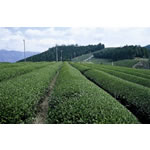Home > Teach me Tea Cha! > Cultivars > Meiryoku
Main content starts here.
Meiryoku
Meiryoku: Durable medium-maturity cultivar resistant to stress such as drought


Processing characteristics
Bud growth and uniformity are good and a stable and high yield can be expected. At the time of development there was worry that the umami would be low and the taste light, but despite the initial concern, it is rated positively as the plainness suits the modern consumers’ tastes. The fragrance is refreshing, and the color and luster is bright and beautiful.
Notes on cultivation
The tree vigor is strong, has a large number of branches, and the appearance is medium. It is a cultivar whose time to maturity is quick, can be easily tailored and easy to produce. Its resistance to cold is also strong. It is resistant to the major diseases of anthrax and ring spot and little control is needed to prevent these diseases. Red blight may occur during the early young stage but rarely in adult trees.
“Meiryoku” is a so-called fertilizer eating cultivar. The same amount of fertilizer used as in “Yabukita” seems to result in a slightly lighter taste and color. Overuse of fertilizer has been a problem in the tea industry for a few years. If a rich tea is desired, it is best achieved from among other cultivars. With “Meiryoku”, it is recommended to use creative with cultivation and production techniques to bring out its attractive and refreshing aroma and taste.
Notes on processing
In terms of harvest, “Meiryoku” is a medium-maturity cultivar but the harvest occurs strictly one or two days earlier than “Yabukita”. The vigor of the tree is strong, the growth of the shoots is active, the state of leaves to become fully open does not occur frequently, meaning new leaves tend to open constantly; it is necessary to be careful so as to not to miss the time of harvest. Picking buds according to their appearance allows for a good selection of shape and quality, but the quality deteriorates drastically after the appropriate period, so we recommend picking 1 or 2 days earlier than “Yabukita”. “Meiryoku” was originally a high yield cultivar, therefore even if it is plucked early, it is possible to obtain a higher yield than “Yabukita”. It can be delivered 2 to 3 days earlier than “Yabukita”, and as a result, the profit can be exceeded even if the unit price drops a little.
Dissemination and land suitability for cultivation
The cultivation area of “Meiryoku” within Shizuoka Prefecture is 26.8 ha. This represents an increase within Shikoku which was triggered by a drought in 1993. Kagawa Prefecture has been actively promoting the introduction of “Meiryoku” as it proved to be resilient during the drought. Within Kagawa, the cultivation area has expanded to 13.0 ha. In Kochi Prefecture, “Meiryoku” was designated as a recommended cultivar in 1998 and 7.0 ha has been devoted to its cultivation including the area of Higashitsunomura, a region which experiences strong cold. “Meiryoku” has also been introduced in Okinawa Prefecture.
